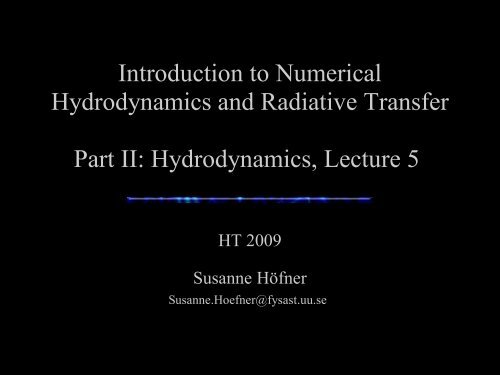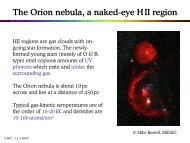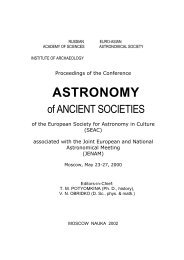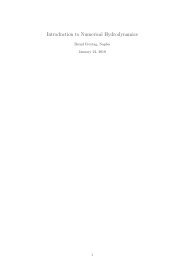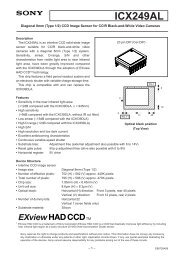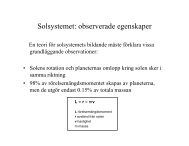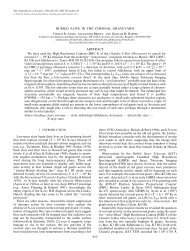lecture notes
lecture notes
lecture notes
Create successful ePaper yourself
Turn your PDF publications into a flip-book with our unique Google optimized e-Paper software.
Introduction to Numerical<br />
Hydrodynamics and Radiative Transfer<br />
Part II: Hydrodynamics, Lecture 5<br />
HT 2009<br />
Susanne Höfner<br />
Susanne.Hoefner@fysast.uu.se
Introduction to Numerical Hydrodynamics<br />
2. The Linear Advection Equation<br />
2.6 PLM and Non-linear Schemes
Linear Advection – The Story So Far ...<br />
first order schemes:<br />
modified equation: advection-diffusion equation<br />
∂ <br />
∂t<br />
u ∂ <br />
∂ x = D ∂2 <br />
∂ x 2<br />
→ diffusive behaviour of the numerical solution
Linear Advection – The Story So Far ...<br />
second order schemes:<br />
modified equation: dispersive equation<br />
∂ <br />
∂t<br />
u ∂ <br />
∂ x = ∂3 <br />
∂ x 3<br />
→ oscillating behaviour of the numerical solution<br />
waves:<br />
group velocity<br />
c g = u + 3µ k2<br />
µ < 0 µ > 0<br />
c g < u<br />
c g > u
Numerical Schemes ... Alternatives<br />
Question:<br />
How to construct a numerical scheme for advection which is more<br />
accurate than a first-order scheme (less diffusion, sharper<br />
gradients), but which doesn't develop oscillations like the second<br />
order schemes which we have investigated so far<br />
Let's start with recalling a few important concepts ...
Integral Form and Flux Centering<br />
Any solution of the advection equation in differential form<br />
involves derivatives.<br />
However, any function – even a discontinuous one – can be<br />
propagated along characteristics (see, e.g., Homework 1).<br />
In certain cases, it may be important to avoid derivatives and/or<br />
discontinuities.<br />
Transformation: linear advection equation in integral form:<br />
Figure courtesy of Bernd Freytag<br />
... for one grid cell and one time step:
Update Formula in Conservation Form<br />
After computing the fluxes at the cell boundaries<br />
that characterize a method<br />
(e.g. from the fluxes in the cells: )<br />
the update can be done by the formula<br />
This is the conservation form because the density changes only<br />
due to fluxes through the boundaries, and is conserved otherwise:
Update Formula in Conservation Form<br />
After computing the fluxes at the cell boundaries<br />
that characterize a method<br />
(e.g. from the fluxes in the cells: )<br />
the update can be done by the formula<br />
This is the conservation form because the density changes only<br />
due to fluxes through the boundaries, and is conserved otherwise.<br />
Guidelines for improved advection:<br />
- keep conservation form<br />
- define more accurate fluxes (reduce diffusion or oscillations)
Improving Advection – RSA Algorithm<br />
Reconstruct – Solve – Average (RSA):<br />
Godunov-type finite-volume scheme<br />
1. Reconstruct ρ(x) from the discrete values ρ i<br />
n (cell averages)<br />
2. Solve the exact problem for ∆t<br />
3. Average this function over each grid cell to obtain ρ i<br />
n+1<br />
Steps 2 and 3 are well-behaved (e.g., conservative) by default,<br />
step 1 is potentially a problem.<br />
Piecewise constant reconstruction (constant value in cell)<br />
→ Godunov's method
Improving Advection – PLM Schemes<br />
The dispersive equation<br />
with<br />
∂ <br />
∂t<br />
u ∂ <br />
∂ x = ∂3 <br />
∂ x 3<br />
0<br />
for<br />
∣ u t<br />
x ∣ 1 c g<br />
u<br />
(Lax-Wendroff)<br />
or<br />
0<br />
for<br />
∣ u t<br />
x ∣ 1 c g<br />
u<br />
(Beam-Warming)<br />
original PDE (linear advection equation):<br />
- constant amplitude (no growth or decay)<br />
- no dispersion (all waves travel at same speed)
PLM Schemes – Examples of Slopes<br />
The dispersive equation<br />
with<br />
∂ <br />
∂t<br />
u ∂ <br />
∂ x = ∂3 <br />
∂ x 3<br />
0<br />
for<br />
∣ u t<br />
x ∣ 1 c g<br />
u<br />
(Lax-Wendroff)<br />
or<br />
0<br />
for<br />
∣ u t<br />
x ∣ 1 c g<br />
u<br />
(Beam-Warming)<br />
original PDE (linear advection equation):<br />
- constant amplitude (no growth or decay)<br />
- no dispersion (all waves travel at same speed)
PLM Schemes – Examples of Slopes<br />
Example: Lax-Wendroff ... the RSA perspective<br />
... applied to piecewise constant data •<br />
• • •<br />
• • •<br />
advection<br />
u∆t = ∆x/2<br />
→<br />
• •<br />
•<br />
•<br />
• •<br />
reconstruction<br />
new cell averages<br />
→ too steep slope causes oscillations ...
PLM Schemes – Examples of Slopes<br />
Example: Lax-Wendroff ... the RSA perspective<br />
... applied to piecewise constant data •<br />
• • •<br />
• • •<br />
advection<br />
u∆t = ∆x/2<br />
→<br />
• •<br />
•<br />
•<br />
• •<br />
reconstruction<br />
new cell averages<br />
→ too steep slope causes oscillations ...
PLM Schemes – Examples of Slopes<br />
Example: Lax-Wendroff ... the RSA perspective<br />
... applied to piecewise constant data •<br />
• • •<br />
• • •<br />
advection<br />
u∆t = ∆x/2<br />
→<br />
• •<br />
•<br />
•<br />
• •<br />
reconstruction<br />
new cell averages<br />
→ too steep slope causes oscillations ...
PLM Schemes – Examples of Slopes<br />
Example: Lax-Wendroff ... the RSA perspective<br />
... applied to piecewise constant data •<br />
• • •<br />
• • •<br />
advection<br />
u∆t = ∆x/2<br />
→<br />
reconstruction<br />
new cell averages<br />
→ too steep slope causes oscillations ...
PLM Schemes – Examples of Slopes<br />
Example: Lax-Wendroff ... the RSA perspective<br />
... applied to piecewise constant data •<br />
• • •<br />
• • •<br />
advection<br />
u∆t = ∆x/2<br />
→<br />
• •<br />
•<br />
•<br />
• •<br />
reconstruction<br />
new cell averages<br />
→ too steep slope causes oscillations ...
PLM Schemes – Examples of Slopes<br />
Example: Lax-Wendroff ... the RSA perspective<br />
... applied to piecewise constant data •<br />
• • •<br />
• • •<br />
advection<br />
u∆t = ∆x/2<br />
→<br />
• •<br />
•<br />
•<br />
• •<br />
reconstruction<br />
new cell averages<br />
→ too steep slope causes oscillations ...
Improving Advection – Monotonicity<br />
The dispersive equation<br />
with<br />
∂ <br />
∂t<br />
u ∂ <br />
∂ x = ∂3 <br />
∂ x 3<br />
0<br />
for<br />
∣ u t<br />
x ∣ 1 c g<br />
u<br />
(Lax-Wendroff)<br />
or<br />
0<br />
for<br />
∣ u t<br />
x ∣ 1 c g<br />
u<br />
(Beam-Warming)<br />
original PDE (linear advection equation):<br />
- constant amplitude (no growth or decay)<br />
- no dispersion (all waves travel at same speed)
PLM Schemes – Slope-Limiter<br />
The dispersive equation<br />
with<br />
∂ <br />
∂t<br />
u ∂ <br />
∂ x = ∂3 <br />
∂ x 3<br />
0<br />
for<br />
∣ u t<br />
x ∣ 1 c g<br />
u<br />
(Lax-Wendroff)<br />
or<br />
for<br />
(Beam-Warming)<br />
original PDE (linear advection equation):<br />
- constant amplitude (no growth or decay)<br />
- no dispersion (all waves travel at same speed)
PLM Scheme with Minmod Slope-Limiter<br />
∂ y<br />
∂t<br />
= D ∂2 y<br />
∂ x 2<br />
Figures courtesy of Bernd Freytag<br />
Stencil diagram and test result (initial condition: red, solution:<br />
blue) for PLM scheme with minmod slope-limiter
PLM Scheme with van Leer Slope-Limiter<br />
∂ y<br />
∂t<br />
= D ∂2 y<br />
∂ x 2<br />
Figures courtesy of Bernd Freytag<br />
Stencil diagram and test result (initial condition: red, solution:<br />
blue) for PLM scheme with van Leer slope-limiter (harmonic<br />
mean of slopes)
PLM Scheme with Superbee Slope-Limiter<br />
∂ y<br />
∂t<br />
= D ∂2 y<br />
∂ x 2<br />
Figures courtesy of Bernd Freytag<br />
Stencil diagram and test result (initial condition: red, solution:<br />
blue) for PLM scheme with Superbee slope-limiter
PPM Scheme<br />
∂ y<br />
∂t<br />
= D ∂2 y<br />
∂ x 2<br />
Figures courtesy of Bernd Freytag<br />
Stencil diagram and test result (initial condition: red, solution:<br />
blue) for PPM scheme with piecewise parabolic reconstruction<br />
(Colella & Woodward, 1984)
WENO Scheme<br />
∂ y<br />
∂t<br />
= D ∂2 y<br />
∂ x 2<br />
Figures courtesy of Bernd Freytag<br />
Stencil diagram and test result (initial condition: red, solution:<br />
blue) for WENO scheme with weighted essentially non-oscillatory<br />
reconstruction (6 th order polynomials, without any Runge-Kutta<br />
sub-steps), see, e.g., Jiang & Shu (1996)


